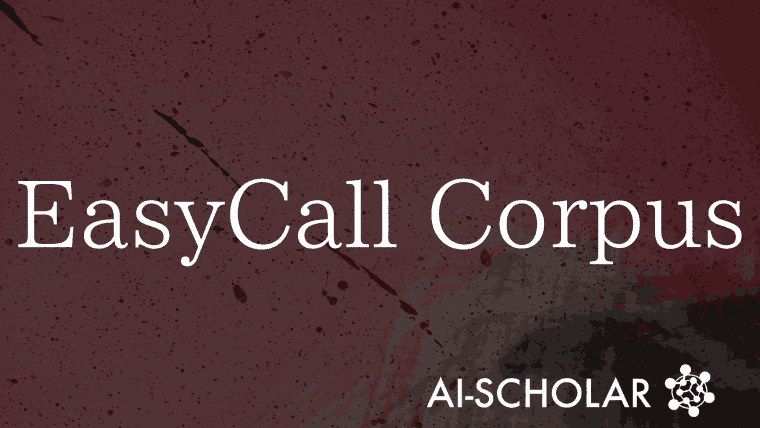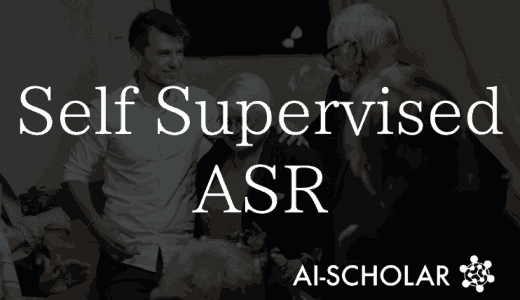
Equal Access To Convenience! EasyCall Corpus", A Speech Corpus For The Dysarthric
3 main points
✔️ 31 dysarthric voices are recorded
✔️ It is clear that existing speech recognition systems do not adequately recognize dysarthric speech.
✔️ It is expected to be used for further development of dysarthric speech recognition technology
EasyCall corpus: a dysarthric speech dataset
written by Rosanna Turrisi, Arianna Braccia, Marco Emanuele, Simone Giulietti, Maura Pugliatti, Mariachiara Sensi, Luciano Fadiga, Leonardo Badino
[Submitted on 6 Apr 2021]
Subjects: Computation and Language (cs.CL)
code:
The images used in this article are from the paper, the introductory slides, or were created based on them.
This Reality That Those with Disabilities Cannot Grasp The Fruits of Convenience...

Read at Least This Part! Super Summary of The Paper!
Do you know what dysarthria is? Dysarthria is a disorder in which a person understands pronunciation but is unable to pronounce it correctly due to problems in the nervous system or speech organs. It seems that there are nearly 4 million people with dysarthria in Japan.This paper presents a study of dysarthria in Italy.
We are increasingly relying on voice to investigate devices such as smartphone apps and smart home technology, aren't we? That's because advances in voice recognition technology have improved recognition accuracy and noise tolerance. What? That's very convenient. Everyone is happy, happy, happy! It's not that science and technology are great.
Modern speech recognition systems are not adequate for people with dysarthria because their pronunciation is often very different from the speech of normal people. In other words, they cannot benefit from voice manipulation at all.
To this end, Italian researchers gathered 31 dysarthric people and developed the EasyCall corpus. The focus of this corpus is the behavior of dysarthric people using voice control to operate their smartphones and make phone calls.

This corpus is a large corpus of recorded speech from 31 dysarthric and 21 normal subjects. Using this corpus, we tested existing speech recognition systems and found that the recognition of dysarthric speech is still more difficult than that of normal speech.
Research on dysarthria is a niche field, so there are often no or few corpora available. This seems to have been the case in Italy as well, and it is hoped that this corpus will help advance research on dysarthric speech.
Supplement: as of 2024. There are no open source dysarthric speech datasets available in Japan. Researchers are collecting data and conducting experiments individually. Why don't you all just share what you have collected individually?
You would think. But that is not possible. It's because of the specification of the text to be used for speechreading. It is very hard to create a corpus, but it is difficult to develop this field in Japan unless someone creates and shows it...
So many problems to research. ....
What Kind of Corpus is The EasyCall Corpus...

Look at this - this is massive!
If you are reading the article on your phone, the letters in this figure are too small to see, right?
There is no particular meaning to this figure, we just wanted you to get a sense of the large scale of this corpus, so please do not try to zoom in and read it.
Now, let's dig a little deeper into this corpus, shall we?
 All of the people recorded in this corpus are 18 years of age or older, and you have used dysarthric speech, which is attributed to various diseases and disorders, including Parkinson's disease.
All of the people recorded in this corpus are 18 years of age or older, and you have used dysarthric speech, which is attributed to various diseases and disorders, including Parkinson's disease.
I am not a medical professional and do not know the details, but I have the impression that many of the diseases listed here are diseases that weaken the muscular and nervous systems.

As mentioned in the previous summary, this corpus contains many voice recordings of situations involving voice control of a smartphone and voice control of a telephone call.
For example, it could be typing a phone number or scrolling down.
I don't use the phone very often, so I wonder if this is practical. I wonder if this is practical, since I don't use the phone very often, but I know that working people use the phone a lot.
Very practical data.
Will Dysarthric Speech Be Recognized?

Well, now that we have created such a large corpus, we want to measure it and understand its current status, don't we?
In this paper, the figures are measured using a speech recognition system provided by Microsoft and IBM.
These numbers are WERs, which indicate the probability (%) that a word unit was misrecognized.
Therefore, the lower the number, the better. In this case, it seems that they are comparing the speech of a normal person and a dysarthric person without fine tuning,
Looking at the table above, we see that the healthy voice is recognized without any problem. Now let's look at the recognition of the disabled person's voice (right side).
Yeah, I'm not sure. Well, as expected, you don't recognize it at all.
Why is dysarthric speech not recognized? This is because existing models are trained on the basis of normal speech. Speech recognition models cannot output anything that has not been learned.
Dysarthric speech is as multilingual as it gets in terms of speech recognition models. There is a huge gap between normal speech and dysarthric speech.
As mentioned in this paper, it is not possible for existing healthy-people-based systems to adequately address this issue. It will be necessary to prepare a dysarthric speech corpus like the EasyCall corpus and develop a system specialized for the dysarthric.
To Ensure That Disabled and Able-Bodied People Enjoy Equal Convenience Regardless of Their Disability. ....
This may be a bit radical, but there is no such thing as equality in this world. There are those who loudly preach that this is the age of diversity and that everyone is equal, but this is nothing more than a theoretical theory.
After all, there are a wide variety of people in this world, including both able-bodied people and people with disabilities, and there is a clear difference between the two. What is truly needed in this world is not equality, but consideration or a kind heart to extend a helping hand.
Having said that, I would like everyone to be able to enjoy equally at least the conveniences that result from science and technology, and I think this is something that needs to happen.
Researchers are exploring every day to realize a society where everyone can enjoy convenience equally. It's cool and I admire it!
If there are any readers who read my articles, this topic is always there! I know that some of you might say, "Oh, I'm just cutting corners! But what I want you to think about the most in my research is this topic, "What is equality? I think this is the topic I want you to think about most when you read my research .
It doesn't matter if other people ridicule you for being a hypocrite. Even if you think differently in your heart, the act itself is clearly good.
They have no right to ridicule you if they don't even dare to take action in the first place.
I believe that if you believe in the goodness and equality within you and act with your heart, the world will be filled with kindness.
A Little Chat with A Chick Writer, Ogasawara

We are looking for companies and graduate students who are interested in conducting collaborative research!
His specialty is speech recognition (experimental), especially with dysarthric people.
This field has limited resources available, and there will always be a limit to what one person can tackle alone.
Who would like to join us in solving social issues using the latest technology?
Categories related to this article








